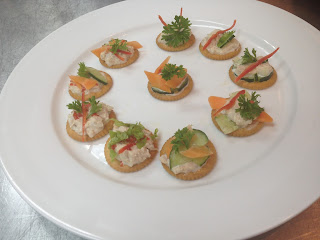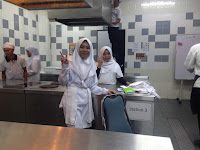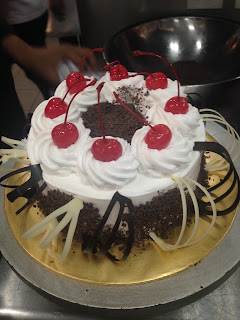INTERNATIONAL CUISINE - WEEK 5 (ENGLAND CUISINE & CHINESE CUISINE)
Introduction
of England and Chinese Cuisine
- - In
week 5, we learn about the England cuisine because that in our syllables for
International Cuisine. Other than that, we learn about Chinese cuisine the menu
is Koh Loo Mee Ayam and for the menu of England cuisine is Chicken Lasagna. And
for the week 5, I become the helper for SOD (service on duty). In that week, we
didn’t use fine dining because we do COD (charges on delivery) we delivery to
customer that order our menu.
History
of England Cuisine and Chinese Cuisine
-
English cuisine encompasses the cooking styles, traditions and recipes
associated with England. It has distinctive attributes of its own, but
also shares much with wider British cuisine, partly through the
importation of ingredients and ideas from North America, China,
and India during the time of the British Empire and as a
result of post-war immigration.
Traditional meals have ancient origins, such as bread and cheese,
roasted and stewed meats, meat and game pies, boiled vegetables and
broths, and freshwater and saltwater fish. The 14th-century
English cookbook, the Forme of Cury, contains recipes for
these, and dates from the royal court of Richard II.
English cooking has been influenced by foreign ingredients and
cooking styles since the Middle Ages. Curry was introduced from
the Indian subcontinent and adapted to English tastes from the
eighteenth century with Hannah Glasse's recipe for chicken
"currey". French cuisine influenced English recipes
throughout the Victorian era. After the rationing of the Second World
War, Elizabeth David's 1950 A Book of Mediterranean Food had
wide influence, bringing Italian cuisine to English homes. Her
success encouraged other cookery writers to describe other styles,
including Chinese and Thai cuisine. England continues to
absorb culinary ideas from all over the world.
-
Chinese cuisine is an important part of Chinese culture, which
includes cuisine originating from the diverse regions of China, as well as
from Chinese people in other parts of the world. Because of the Chinese
diaspora and historical power of the country, Chinese cuisine has
influenced many other cuisines in Asia, with modifications made to cater
to local palates.
The preference for seasoning and cooking
techniques of Chinese provinces depend on differences in historical
background and ethnic groups. Geographic features including
mountains, rivers, forests and deserts also have a strong effect on the local
available ingredients, considering climate of China varies
from tropical in the south to subarctic in the
northeast. Imperial, royal and noble preference also plays a role in
the change of Chinese cuisines. Because of imperial expansion and trading,
ingredients and cooking techniques from other cultures are integrated into
Chinese cuisines over time.
CONTENT
·
lasagne
sheet
·
2
tbsp corn oil
·
1
large onion
·
2
carrots, finely chopped
·
2
celery sticks, finely chopped
·
2
cloves garlic, minced or finely chopped
·
500g
ground chicken
·
800g
tomato puree
·
50g
tomato paste
·
3
tsp sugar
·
1
tsp oregano
·
1
tsp dry basil
·
Salt
and freshly ground black pepper
·
60
g butter
·
40
g
·
Flour
·
560
ml milk
·
½
tsp nutmeg
·
1
00g parmesan
Method:
1.
Prepared
chicken sauces, in a large pan heat oil over medium high heat. Cook the onion
,garlic, carrot and celery over medium heat until softened, stirring constantly
2.
Add
the chicken and cook until it changes its colour, break up any lumps of meat
using a fork.
3.
Add
tomato paste, tomato puree, sugar, oregano, basil, salt and pepper to taste.
Cover, bring to a boil, reduce the heat and simmer for about 1 ½ hrs. Set
aside.
4.
Prepare
the béchamel sauce. In a medium sauce pan, melt the butter over medium-low
heat. Add the flour and stir until smooth, for about 1 minute, until bubbling.
Remove from heat and gradually stir in milk, until mixture is smooth.
5. Return to heat and stir constantly
until the sauce boils and begin to thicken. Add nutmeg, salt and pepper and set
aside until ready to use. Give it a stir from time to time so it doesn’t make a
skin on the surface.
6. Preheat oven to 350 F (180C).
7. Assemble the lasagna. Spread a layer
of chicken sauce (about 1/3 of the sauce) over the bottom of the baking dish.
Spread a thin layer of béchamel (about ½ cup of béchamel sauce).place a single
layer of noodles over top and press gently. Top the last layer of noodles with
remaining béchamel sauce and sprinkle the parmesan over the top. Cook about 25
minutes covered with foil, and another 25 minutes without.
8. Ready to serve.
·
1
chicken breast
·
3
sheet pak choy
·
Garlic
·
Red
onion
·
Daun
sup
·
Daun
bawang
·
Chicken
stock
·
Oyster
suce
·
Soy
sauce
·
sugar
·
2
tsp sesame oil
Methods:
1.
Boil
water; enter chicken stock and chicken breast.
2.
Marinated
the chicken with soy sauce + oysters into the foil and bake 15 minutes
3.
Put
the onion, garlic, leeks and parsley to the water.
4.
Put
the sesame oil.
5.
To
concentrated, place a little corn flour, let it boil
6.
Dip
pak choy to the boiling water then drain
7.
Meanwhile,
sliced the chicken. After that, served
that serve the soup with noodles, slice of chicken and vegetable
Panna cotta recipe
·
1
tbsp gelatine
·
2
cups heavy cream
·
2
cup fresh milk
·
1/3
cup sugar
·
1
½ tsp vanilla extract
Method:
1.
Mix
the fresh milk with the gelatin, stir until soften.
2.
In
another pan, boil heavy cream wait until simmering then mix the gelatin, fresh
milk to the cream. Stir until soften.
3.
Lastly,
cold the cream then put in the cup, for the topping you can put fruit and wait
until harden.
CONCLUSION
In the end of the class,
we have learnt the student must prepare their self before entire the class.
Other than that, the communication is so important for the student to
communicate to other student. More than that, the important is the well
preparation before class because the well preparation is the started for the
success of the work. Other than that, in the end of class, we have learnt how
to become the SOD in that week, the important part was SOD do is they must good
that to attract and find the customer and they must deliver the order to the
right customer.





Comments
Post a Comment